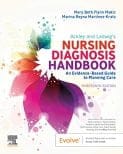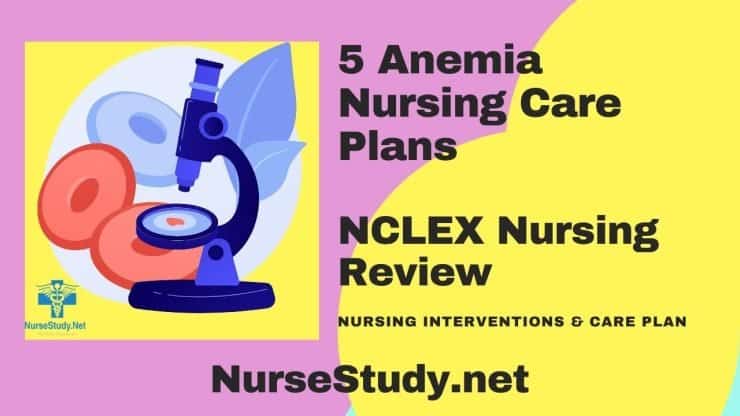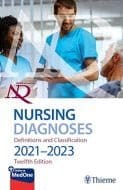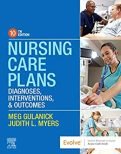

Anemia is a condition characterized by a decrease in the number of red blood cells (RBCs) or a decrease in the amount of hemoglobin in the blood, resulting in reduced oxygen-carrying capacity. The NANDA nursing diagnosis for anemia is formulated as follows:
Imbalanced Nutrition: Less Than Body Requirements related to inadequate intake of iron and vitamins, blood loss, or impaired absorption.
Nursing Care Plan for Anemia
Question 1: A client with anemia reports feeling fatigued and weak even with minimal activity. Which nursing intervention is most appropriate for this client?
a) Encouraging a high-protein diet
b) Assisting with ambulation and mobility
c) Administering pain medication
d) Monitoring blood glucose levels
Answer b: Rationale: The client’s fatigue and weakness are related to decreased oxygen-carrying capacity in anemia. Assisting with ambulation and mobility will help conserve energy and prevent falls.
Question 2: A nursing student is reviewing the laboratory results of a client with suspected anemia. Which finding would support this diagnosis?
a) Elevated hemoglobin levels
b) Low hematocrit levels
c) Increased white blood cell count
d) Elevated platelet count
Answer b: Rationale: Low hematocrit levels indicate a decreased proportion of red blood cells, which is consistent with anemia.
Question 3: A client with anemia is prescribed iron supplements. Which instruction should the nurse provide to the client regarding iron supplementation?
a) Take the supplement with a glass of milk.
b) Take the supplement on an empty stomach.
c) Take the supplement with a high-fiber meal.
d) Take the supplement with a cup of coffee.
Answer b: Rationale: Iron supplements should be taken on an empty stomach for better absorption. Taking them with milk, high-fiber meals, or coffee can interfere with iron absorption.
Question 4: A client with anemia is experiencing shortness of breath and rapid heart rate. Which nursing intervention is a priority for this client?
a) Encouraging deep breathing exercises
b) Administering oxygen therapy
c) Assisting with ambulation
d) Providing emotional support
Answer b: Rationale: Shortness of breath and rapid heart rate are signs of decreased tissue oxygenation. Administering oxygen therapy will help improve oxygen levels and relieve symptoms.
Question 5: A client with anemia is at risk for falls. Which nursing intervention would help prevent falls in this client?
a) Encouraging independence in activities of daily living
b) Providing a well-lit environment
c) Administering anticoagulant medication
d) Encouraging fluid intake
Answer b: Rationale: Providing a well-lit environment reduces the risk of falls by improving visibility and promoting safety.
Ackley, B. J., Ladwig, G. B., Makic, M. B., Martinez-Kratz, M. R., & Zanotti, M. (2020). Nursing diagnoses handbook: An evidence-based guide to planning care. St. Louis, MO: Elsevier.
Gulanick, M., & Myers, J. L. (2022). Nursing care plans: Diagnoses, interventions, & outcomes. St. Louis, MO: Elsevier.
Ignatavicius, D. D., Workman, M. L., Rebar, C. R., & Heimgartner, N. M. (2020). Medical-surgical nursing: Concepts for interprofessional collaborative care. St. Louis, MO: Elsevier.
Silvestri, L. A. (2020). Saunders comprehensive review for the NCLEX-RN examination. St. Louis, MO: Elsevier.
These are the nursing books and resources that we recommend.
NurseStudy.net is a participant in the Amazon Services LLC Associates Program. Included below are affiliate links from Amazon at no additional cost from you. We may earn a small commission from your purchase. Please see our Privacy Policy

This is an excellent reference for nurses and nursing students. While it is a great resource for writing nursing care plans and nursing diagnoses, it also helps guide the nurse to match the nursing diagnosis to the patient assessment and diagnosis.
This handbook has been updated with NANDA-I approved Nursing Diagnoses that incorporates NOC and NIC taxonomies and evidenced based nursing interventions and much more.

All introductory chapters in this updated version of a ground-breaking text have been completely rewritten to give nurses the knowledge they require to appreciate assessment, its relationship to diagnosis and clinical reasoning, and the goal and use of taxonomic organization at the bedside.

It contains more than 200 care plans that adhere to the newest evidence-based recommendations.
Additionally, it distinguishes between nursing and collaborative approaches and highlights QSEN competencies.
Please follow your facilities guidelines, policies, and procedures.
The medical information on this site is provided as an information resource only and is not to be used or relied on for any diagnostic or treatment purposes.
This information is intended to be nursing education and should not be used as a substitute for professional diagnosis and treatment.
Anna Curran. RN-BC, BSN, PHN, CMSRN I am a Critical Care ER nurse. I have been in this field for over 30 years. I also began teaching BSN and LVN students and found that by writing additional study guides helped their knowledge base, especially when it was time to take the NCLEX examinations.